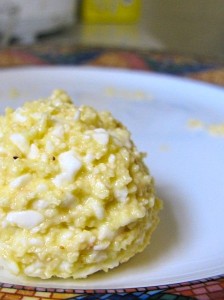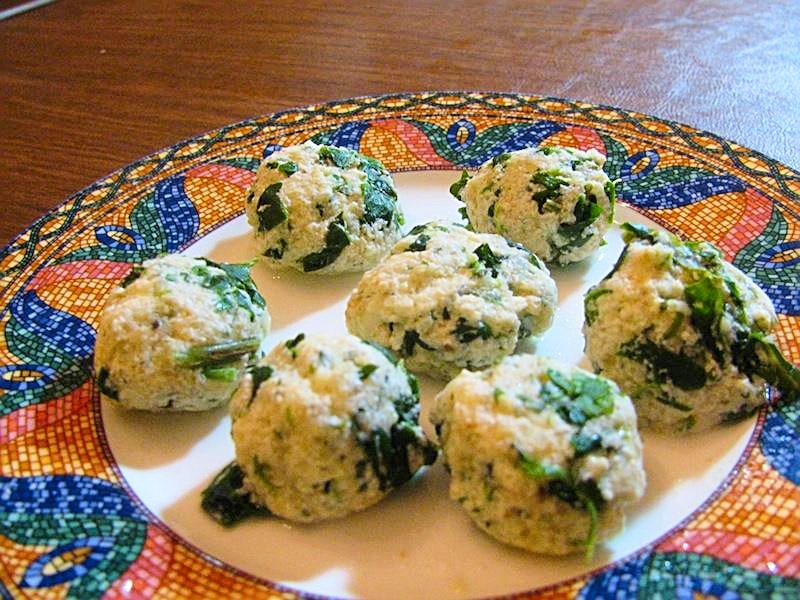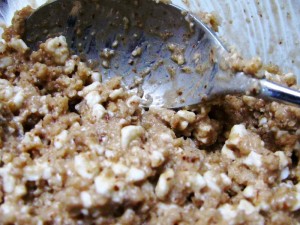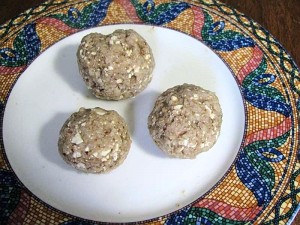A few years ago, my mother gave me our family recipe for Matzah Cheese Balls. My namesake, my great-grandmother Martha, used to make them for my mother when she was a child, but I don’t remember my mother making them for me. I decided to make them for Shavuot this year.
Unfortunately, they turned out bland—too subdued for the modern palate. Undaunted, I decided to fix the recipe, guided by intuition and an occasional visit to The Frying Pan. In contrast to the methodological testing of our previous two posts, I’ll explore a less rigorous, more common approach. How do you fix a recipe when it just doesn’t turn out as you’d like?
This is the family recipe I started from, with metric conversions added:
Matzah Cheese Balls
- 1 pint cottage cheese (approx. 450g)
- 2 eggs
- up to 1 tbsp (12 g) sugar, to taste
- up to 1 tsp (5 g) salt, to taste
- matzah meal added until the mixture holds together as a sticky dough
Combine ingredients, then roll into 2″ diameter balls. Cook in boiling water until they rise to the top. Optionally, allow to cool, then fry in butter. I found that to make sure they are fully cooked, you need to cook them a bit longer — about 4-5 minutes total.
The recipe gives a mildly cheesy, mildly sweet version of a matzah ball. It reminded me a bit of the filling of cheese blintzes — slightly sweet mild cheese. In blintzes, however, they are contrasted with the texture of the crepe-like wrapping.
I love matzah balls, when they’re the big fluffy, doughy lumps that soak up the flavor of good chicken soup. They provide textural contrast to the smooth broth and the bland flavor doesn’t overpower the flavor of the soup. But I have no interest in eating matzah balls by themselves, even if mildly cheesy and sweet, and mixing meat (or poultry) and milk isn’t allowed in kosher cooking.
I figured that in order to eat cheese balls by themselves, instead of with soup, I would need to add more intense flavor. The original recipe only has three main ingredients: cottage cheese, egg, and matzah meal. Eggs hold the dough together, so that limited me to two ingredients to vary.
Varying the ingredients
My first attempt was using sour cream in place of the cottage cheese. I seasoned that version with McCormick chai spice blend, to taste, and a bit more sugar. The result tasted like a mild version of French toast, but without any of the interesting crisp bits you get from frying. This suggested that the browning from frying adds a depth of flavor that cannot be achieved by boiling. The original recipe suggested letting the cheese balls cool, and then frying them in butter, which might add back the caramel notes one gets in french toast. This experiment also suffered because I forgot to add salt to the dough, but I wasn’t interested enough in the results to try the recipe again with salt.
Next, I attempted using yogurt. Greek yogurt, when combined with seasoned bread crumbs and some Italian seasonings (again, I used pre-prepared seasoned breadcrumbs and a pre-mixed seasoning mix to simply try a proof of concept before measuring and carefully evaluating the results) was far too sour. The flavor profile was interesting, since the sour flavor of the yogurt really came through, but the result wasn’t very pleasant to eat.
After consulting with some of my colleagues at Seasoned Advice in a chat room, I attempted my third version. I used ricotta, combined with Parmesan cheese and a bit of shredded mozzarella. After adding the egg, I added salt and pepper, plus some chopped spinach, figuring I’d go the whole way to approach the filling of a spinach lasagna. I grated some nutmeg into the mixture, and then topped off with breadcrumbs.
And once again, the result was—well, not bad per se, but…
I’m afraid that the problem was that boiling simply washes out the flavor, no matter how much seasoning I added to the mixture. I was ready to declare the experiment for a failure, but then I realized that it might be salvaged, if I could only find focus, instead of wildly trying anything that came to mind. I remembered my original evaluation of the cheese balls as reminding me of cheese blintzes, and decided to focus on that idea. Often, cheese blintzes are made with fruit filling as well as the cheese. Perhaps I could go back to the original recipe and simply add fruit.
Adding to the original recipe
To try adding an ingredient to the original recipe, I made a version of the cheese balls adding fruit puree. For this experiment, I also substituted panko for the matzah meal (as I was out of matzah meal and wanted to make a stab at the experiment before going to the store). I used prune puree as is used for hamantashen for the holiday of Purim. My first attempt at prune cheese balls was a complete failure. I underestimated the amount of panko needed for the dough, and the balls fell apart in the boiling water.
The bits I was able to salvage from this experiment were completely flavorless. I hadn’t added enough prune puree. So as I added more panko, I also added more prune puree and some lemon juice to counter the sweetness. (I often add lemon juice to the prune puree for my hamentashen.) I also let the mixture sit approximately five minutes before forming the balls to allow the panko crumbs to absorb moisture from the rest of the ingredients. This allowed the panko to function exactly like breadcrumbs or matzah meal.Finally, success. The sweetness of the prune and the tartness of the lemon provided enough contrast to the mild milky flavor of the cottage cheese and the result was tasty and even something I would consider making for a future Shavuot.
Fruit and Cheese Balls
- 450 g cottage cheese
- 2 eggs
- up to 5 g salt
- sweetened fruit puree (approximately 60-100 ml, or to taste)
- 5-8 ml lemon juice
- matzah meal or bread crumbs added until mixture holds together in a slightly sticky dough (my rough estimate is about 170 g, but this may vary).
- Mix together all ingredients.
- Form into balls 1 to 2 inches in diameter.
- Cook in boiling water 6-8 minutes, or until cooked through.
- Serve immediately, accompanied by fresh fruit or sour cream. Or let cool and fry in butter.
A joyous Shavuot to all!
Editor’s note: This is our first holiday special. Thank you Martha F for writing it. And to all Seasoned Advicers: We are still looking for a 4th of July contribution. If you are interested in writing it, please contact us at cooking.se.blog@gmail.com or answer the Meta Question.
Filed under family recipes holiday specials







Nice post.
Would perhaps sweetening the balls some more and adding only spices (cinnamon and/or nutmeg and/or ginger and/or allspice) be sufficient, without the other additives?
Also: Is sweetened prune puree something you make or buy? Is it the same as lekvar (which is commercially available and which I’ve seen used for Purim hamentaschen)?
Sweetened prune puree is the same as lekvar. I’d be interested to see how it works if you try just adding sweetness and spices.
I made similar balls too when I got the post for editing. I was shocked to notice how bland they were despite me adding quite a bit of flavor. What seems like normal amounts for any other dough gets lost in the waterlogged bread crumbs and also leached into the cooking water. So, if any of you tries alternatives, make sure to make the raw mix very overspiced, so it can taste normal when boiled.